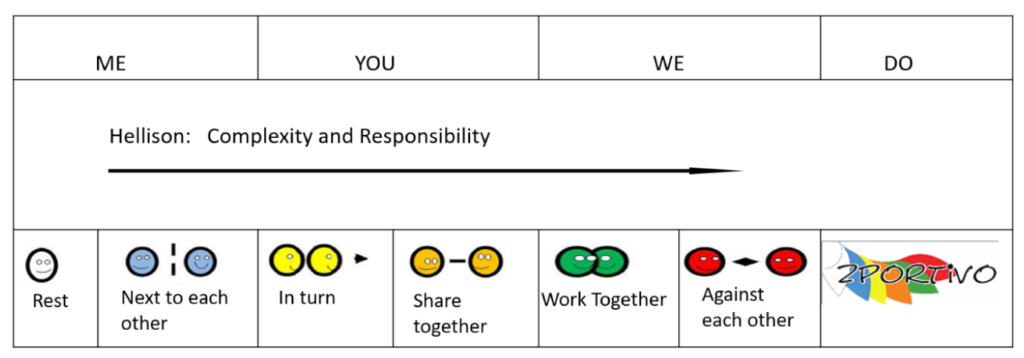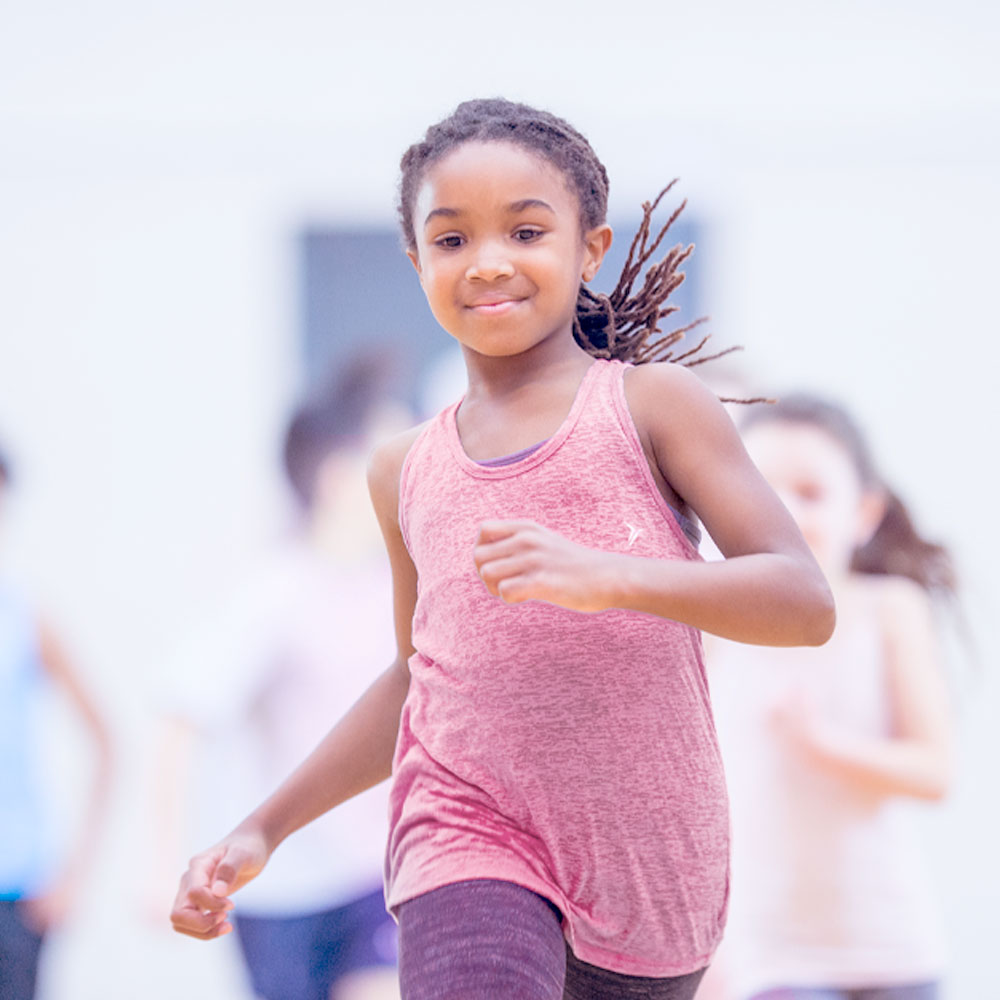
The ‘Rose of Leary’ model distinguishes four different behavioural possibilities:
(1) Submissive (SB), (2) Opposed (OB), (3) Dominant and (4) Together. With this model you can describe behavioural effects of a child on others, such as educators and peers.

Figure 1. The ‘Rose of Leary’ (Leary, 1957Interpersonal Diagnosis of Personality, A functional Theory and Methodology for Personality Evaluation. New York: The Ronald Press Co.)
Social, emotional and relational refers to the ways in which children experience and understand interpersonal relationships and emotions. Children may experience difficulties socially in forming and maintaining friendships or interactions with others. Emotionally children may experience difficulties in recognising their own emotions and the emotions of others, and controlling their emotions. These social, emotional and relational difficulties can be communicated through a range of behaviours, such as, a lack of confidence, over confidence or challenging behaviour.
A model that specifically addresses social, emotional and relational learning is Zportivo and the ‘MeYouWeDo’ colour framework that it advocates (Erik Boot). This model reflects on the complexity of social, emotional and relational behaviours in relation to activities undertaken within the gym, sports field, outdoor settings, classroom or playground. The development of social behaviour usually develops from a starting point of being focused on yourself (Me), to contact with others (You) and ultimately to the collectivity of a group/team (We). Within the Zportivo colour framework six colours depict the social behaviour of activities in the PE setting: white & blue (Me), yellow & orange (You), green & red (We). This colour scheme can be used within physical education lessons to develop a range of differentiated social emotional and relational learning experiences for children to engage with.

Another model that can support social, emotional and relational learning is the Teaching Personal and Social Responsibility (TPSR) model (Hellison, 2011)Teaching responsibility through physical activity. Champaign, IL: Human Kinetics. The focus of this model is on simultaneously developing social, emotional, psychomotor and cognitive knowledge and understanding within physical education contexts for learning. TPSR emphasises supporting children to develop increased responsibility for themselves and towards others by learning about concepts such as self-control, compassion, empathy and respect.
- Create a quiet (low external stimulation) environment for the child. (SB"Submissive" behaviour)
- Create an environment for the child where she can choose what she is going to do by setting up different equipment or providing different materials to accomplish an assignment. (SB)
- Create an environment for the child where he is distracted as little as possible. (OB"Opposed" behaviour)
- Let the child choose in which part of the lesson he is going to participate in the PE lesson (in a lesson with multiple parts). (OB)
- Teach the child to start and stop an activity in a controlled way. (SB"Submissive" behaviour)
- Free play with some materials. (SB)
- Teach the child to be aware of the presence of others in a group. (SB)
- Teach the child to appreciate the child’s possibilities in a positive way. (SB)
- Teach the child to identify the behaviour of others. (SB)
- Teach the child to be able to play next to each other. (OB"Opposed behaviour")
- Do not encourage ego centered behaviour, but accept it if present. (OB)
- Teach the child to discover own possibilities within the tasks. (OB)
- Teach the child to be able to assess himself realistically in a group. (OB)
- Stimulate to demonstrate a technique. (OB)
- Avoid challenging the child too much to perform and too much to determine what happens. (SB"Submissive" behaviour)
- Avoid grumbling. (SB)
- Avoid forgetting about the child. (SB)
- Avoid being impatient. (SB)
- Get into the child’s world. (SB)
- Let the child express feelings. (SB)
- Invite the child by asking open questions (watch out for chaos). (SB)
- Give non-verbal signals. (SB)
- Find thresholds for the child to do it independently of the teacher, for example, let her play together with a partner or provide a step-by-step plan to perform tasks. (SB)
- Let the child determine herself when she is ready for the next step. (SB)
- Check whether the child gets a fair attention. (OB"Opposed" behaviour)
- Check the behaviour of the child rather than the child as a person. (OB)
- Avoid irritation. (OB)
- Avoid authoritarianism. (OB)
- Avoid anger. (OB)
- Avoid rejection. (OB)
- Make preventive appointments with the child outside the group. (OB)
- Do not to blame or punish, but appreciate the child and express affection. (OB)
- Maintain what is going well. (OB)
- Increase the self-regulation of the child. (OB)
- Teach the child to control its anger in an earlier stage. (OB)


“Submissive” behaviour
Free play with some materials:
Linda comes in the gym with some challenging equipment, for example climbing track, swing, slide, etc. Linda can choose from the situations and decide for herself what to do.
Obstacle course:
Linda runs over the course and experiences how others move and jump. Linda is asked to observe the others with a specific point of interest
Climbing the bench side by side:
Linda runs into a double sloping bench and could get higher and higher. Linda estimates her ability in advance and then goes on to practice and possibly move a little higher. She may practice several times using her hands to help get higher.
Changing trees:
Every child has its own “tree” in the gym (Pylon). They try to switch to each other’s tree before the “forest ranger” gets hold of the free tree. How do you think he/she plays this game? What did you see? Have you seen something clever? Did you play nicely? Do you have any tips? Reflection: Did you say things you thought or felt towards the others?
“Opposed” behaviour
Box jump:
Erik jumps into a defined area in the gym with a trampoline over a vaulting box with a landing strip behind it. Erik may choose himself how to jump over the box, as long as it is safe. There are clear agreements/rules about how to keep playing in your own area.
Parkour with stopwatch using individual stations:
Erik participates in a challenging movement parkour with a box, mat, bench and the wall rack for example in a delineated area. He keeps track of his time with a stopwatch from the start
Side by side rope swinging:
Erik practices swinging on a rope from bench to bench. If he succeeds to land on the bench at the other side, the benches will be put at greater distance from each other. Sometimes he has to wait for another person who is swinging first. Maybe he needs help with this. He is stimulated to demonstrate his technique of ‘swinging at great distance’ to others on a trajectory that he has mastered.
Taking turns riding a skateboard:
Erik goes down on a sloping double bench, hanging on the wall rack, sitting on a skateboard. He is in a small group and has to hand over the material to others and wait for his turn. The communication while waiting is of great importance to learn to wait ‘pleasantly’. He receives compliments for waiting well (and of course) during the exercise itself.

The development of empathy-related responding. In G. Carlo & C. P. Edwards (Eds.), Eisenberg, N. (2005).
Moral motivation through the life span (pp.73-117). Lincoln, NE: University of Nebraska Press.
Teaching responsibility through physical activity, Hellison, D. (2011).
Champaign, IL: Human Kinetics.
Addressing and navigating the social domain in sport, Jacobs, F. (2016).
Coaches and physical education teachers. Enschede: Gildeprint.
Interpersonal Diagnosis of Personality, Leary, T. (1957).
A functional Theory and Methodology for Personality Evaluation. New York: The Ronald Press Co.
Dancing with your eyes
Dancing with your eyes is an interview with Róisín Kelly, a Generalist Primary Teacher with a keen interest in Physical Education, and Susan Marron a lecturer of Physical Education at The Institute of Education Dublin City University. Róisín describes the teaching strategies that she implements in her teaching to develop meaningful Physical Education learning experiences for her pupils with additional needs with a focus on autism.
Episode 75 (Video File)Zportivo
Zportivo is an organization with a playful method to teach children, young people and the elderly how to play and exercise together more independently. With ZPORTIVO you not only make playing and moving important within your organization, you also promote the motivation, involvement, fun and creativity of the mover. With Zportivo's 'MeYouWeDo' color model you can link the complexity of socially emotional relational behaviour to all the activities that you can do in the gym, sports field, forest, classroom or playground.
The Wee Worry Workshop
A Health and Wellbeing intervention developed at Park View Primary School, South Lanarkshire. The aim of the intervention is to support pupils who have difficulties related to social and emotional communication and/or display anxiety. This was identified as part of an on-going self-evaluation exercise to improve outcomes for children and formed part of discussions with parents about their children’s progress.
Let’s Play Together
Let’s Play Together is an Inclusive games resource aim to be all-encompassing and enable all children of differing abilities to engage in sports and games together with a focus on physical, intellectual, autism spectrum, visual and hearing impairments. Singapore Disability Sports Council (2015). Let’s Play Together.
Download PDFCircle Resource
This resource aims to bring together and share good inclusive practice, focusing on approaches to improve the engagement and achievement of all learners including those who require additional support.
Download PDFUnified PE
Unified PE at Torrence Creek Elementary. This short video of 2 minutes shows strategies used at an elementary school to include children with autism in physical education.
Video- Eisenberg, N. (2005). The development of empathy-related responding. In G. Carlo & C. P. Edwards (Eds.), Moral motivation through the life span (pp.73-117). Lincoln, NE: University of Nebraska Press.
- Hellison, D. (2011). Teaching responsibility through physical activity. Champaign, IL: Human Kinetics.
- Jacobs, F. (2016). Addressing and navigating the social domain in sport: Coaches and physical education teachers. Enschede: Gildeprint.
- Leary, T. (1957). Interpersonal Diagnosis of Personality, A functional Theory and Methodology for Personality Evaluation. New York: The Ronald Press Co.











